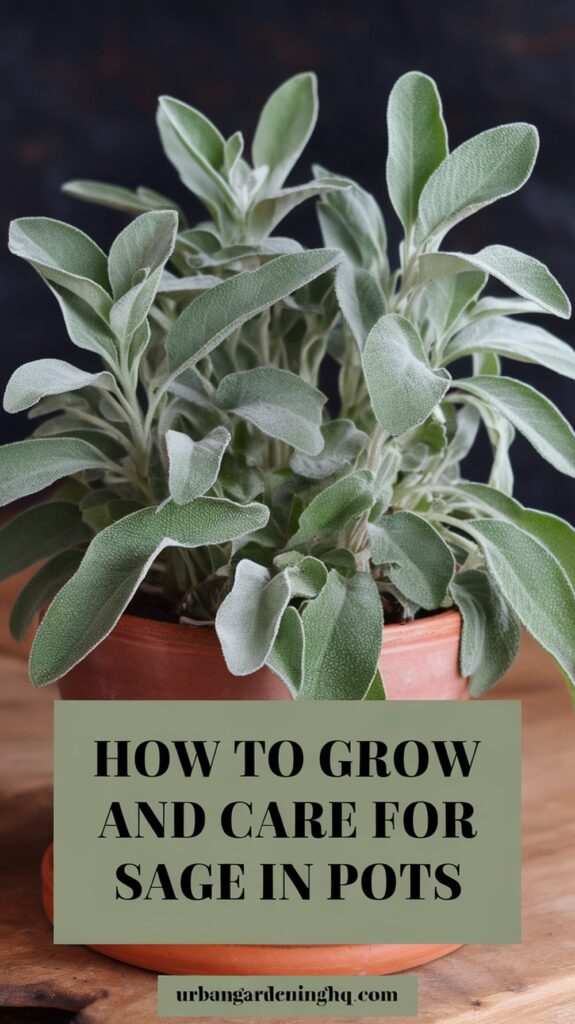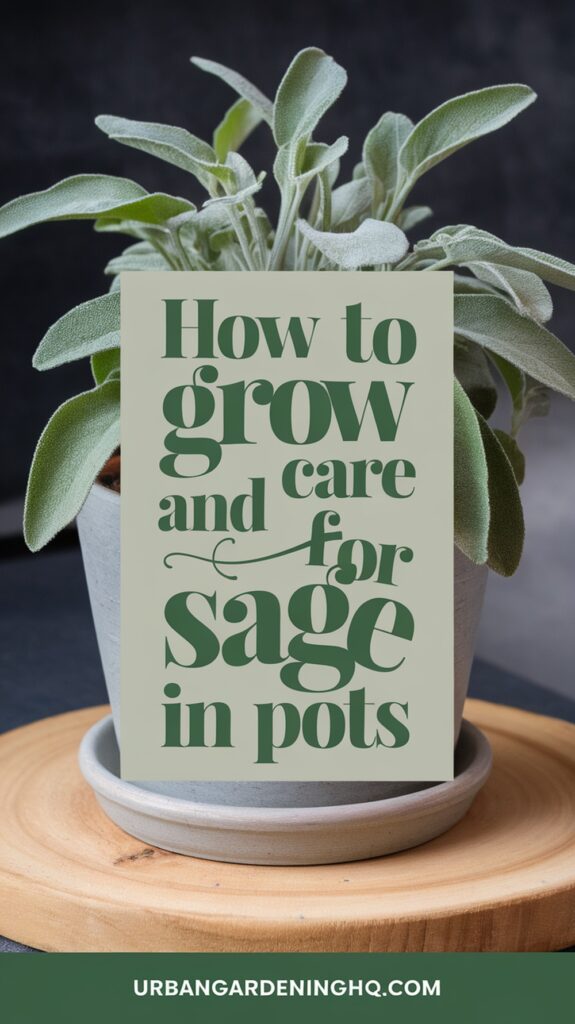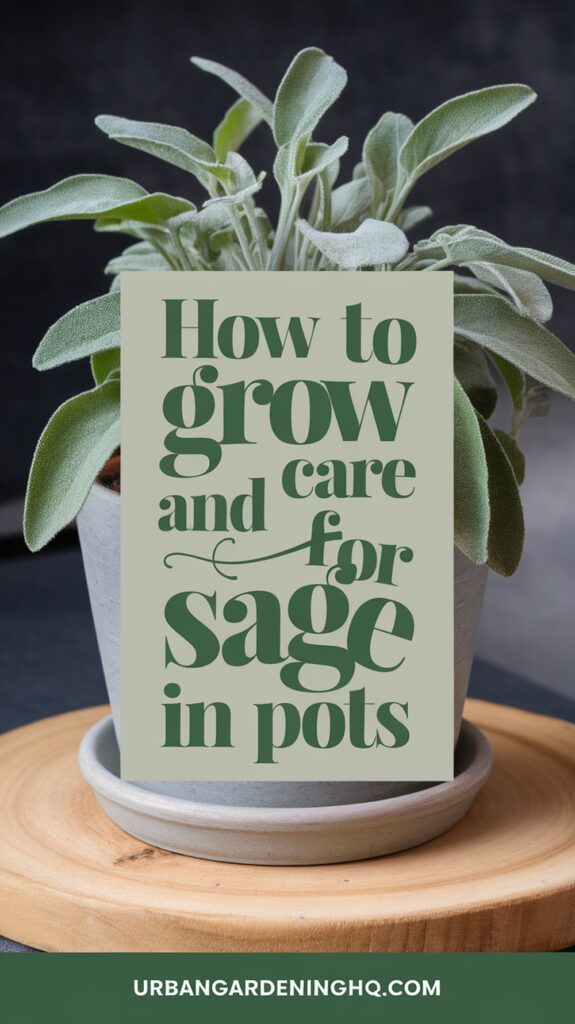Growing sage in pots is rewarding for both new and seasoned gardeners. Sage (Salvia) does well in containers, providing soft leaves and vibrant purple flowers. These add beauty to your patio or kitchen windowsill.
From my experience, growing sage in pots is quite simple. With the right care, your sage will offer fresh flavors and a Mediterranean vibe all year
This guide will cover the basics of sage care, from picking the right pot to keeping it healthy. You’ll learn about sunlight, watering, and protecting your sage during winter. By the end, you’ll know how to grow and care for sage in pots, whether you have one or many.
Growing sage in pots is rewarding for both new and seasoned gardeners. Sage (Salvia) does well in containers, providing soft leaves and vibrant purple flowers. These add beauty to your patio or kitchen windowsill.
From my experience, growing sage in pots is quite simple. With the right care, your sage will offer fresh flavors and a Mediterranean vibe all year.
This guide will cover the basics of sage care, from picking the right pot to keeping it healthy. You’ll learn about sunlight, watering, and protecting your sage during winter. By the end, you’ll know how to grow and care for sage in pots, whether you have one or many.
Why Sage Makes an Excellent Potted Herb

Growing sage in containers is a great way to have fresh herbs all year. It adds flavor to dishes and has health benefits. It’s perfect for small spaces and sunny spots.
Culinary and Medicinal Benefits of Homegrown Sage
Sage’s strong flavor is great in soups, sausages, and desserts. It’s also good for your health, helping with breathing and boosting your immune system. This makes it a valuable plant in your kitchen and garden.
Advantages of Growing Sage in Containers vs. Garden Beds
Container garden sage has many benefits:
- It’s easy to move to get more sun or protect from frost.
- You can control the soil’s pH and drainage.
- It won’t spread out like it can in the garden.
- It’s good at handling dry spells, so you don’t have to water it as much.
- You can bring it inside to keep it growing all year.
Varities of Sage Best Suited for Container Growing
Here are some top picks for container growing:
| Variety | Features | Best Use |
|---|---|---|
| Common Sage (Salvia officinalis) | Classic flavor, silver-green leaves | Stufings, teas, pest repellent |
| Purple Sage (S. officinalis ‘Purpurascens’) | Deep purple foliage for decor | Ornametal pots or garnishes |
| Tricolor Sage | Pink, green, and white leaves | Window sill accents |
| Compact Sage | Smaller growth habit | Balcony or kitchen counter pots |
These varieties do well in pots, adding flavor and beauty to small spaces. Next, we’ll look at choosing the right container.
Selecting the Perfect Container for Your Sage Plant
Finding the right pot is key for potted sage care. Choose a pot that’s at least 12 inches wide and deep. This size helps roots grow well. Terracotta or clay pots are best because they dry fast and prevent waterlogging.
Drainage holes are a must. Without them, roots can rot, a big problem in potted sage care.
Here are key tips for growing sage in pots:
- Choose terracotta or unglazed clay pots for natural evaporation and breathability.
- Plastic pots work too if they’re glazed or have drainage holes.
- Use Miracle-Gro® Performance Organics® All Purpose Container Mix for optimal soil retention and airflow.

| Container Material | Pros | Best Use |
|---|---|---|
| Terracotta | Excellent drainage, porous, lightweight | Single sage plants or small herb clusters |
| Plastic | Cost-effective, lightweight, retains moisture longer | Beginner gardeners or indoor setups |
| Concrete/Stone | Stylish, durable, retains heat | Outdoor spaces needing permanence |
For growing multiple herbs, use an 18-inch pot. This size is great for sage with thyme or parsley. Start with gravel or Scotts Osmocote® Plus Organics mix at the bottom for better drainage. Place pots on feet to stop water from pooling. These tips help your sage grow well, adding beauty and function to any area.
Essential Soil Requirements for Potted Sage
Healthy soil is key for thriving sage, whether indoors or outdoors. Sage loves fast-draining soil to prevent waterlogged roots. Let’s explore the best mix for success.
Best Soil Mixtures for Optimal Drainage
A balanced mix is essential. It should hold moisture but also drain well. Here’s a simple recipe:
| Component | Percentage | Purpose |
|---|---|---|
| Premier Pro-Mix or Miracle-Gro® Container Mix | 60% | Base for nutrients and structure |
| Coarse sand or perlite | 20% each | Prevents compaction and improves airflow |
| Composted organic matter | 10% | Adds slow-release nutrients |
For outdoor potted sage, add more sand in heavy clay soils. Indoor growers can use this mix in terracotta pots to boost evaporation.
pH Considerations for Healthy Sage Growth
Sage thrives in slightly alkaline soil (pH 6.0–7.0). Use a soil test probe to check levels. Here’s how to adjust:
- Too acidic (
- Too alkaline (>7.0)? Mix in compost or sulfur.
Keep the pH in range to avoid nutrient lockout. Both indoor sage plant care and outdoor setups need annual pH checks in spring.
How to Grow and Care for Sage in Pots: A Step-by-Step Guide

Starting your sage journey is simpler than you think. Follow these steps to ensure your plants thrive from day one.
Starting Sage from Seeds vs. Cuttings
Choose your method based on time and patience:
- Seeds: Sow in seed compost 6–8 weeks before the last frost. Cover with perlite and keep at 65–70°F. Germination takes 3 weeks. Transplant seedlings once they’re 4 inches tall.
- Cuttings: Clip 3-inch stem tips, dip in rooting hormone, and plant in sand/vermiculite. Roots form in 6 weeks. Transfer to a 10-inch pot once rooted.
Proper Planting Depth and Spacing
Plant sage so its crown sits level with the soil surface. Space multiple plants 12 inches apart in large pots. Here’s why pot choice matters:
| Pot Type | Best For | Tip |
|---|---|---|
| Terracotta | Balanced moisture | Excellent drainage but dries faster |
| Plastic | Cost-effective | Use with saucers to prevent overwatering |
| Ceramic | Moisture retention | Perfect for consistent watering schedules |
Initial Watering and Establishment Tips
Give your sage a strong start with these steps:
- Water thoroughly after planting, ensuring soil is evenly moist.
- Shelter young plants from wind and frost for the first 2 weeks.
- Reduce watering to once weekly after 4 weeks. Let soil dry slightly between waterings.
Patience is key during the first month. Healthy roots mean lush growth! Visit your local nursery for Miracle-GRO® soil mix to boost soil quality. With these steps, your How to Grow and Care for Sage in Pots journey will set the stage for years of harvests.
Optimal Sunlight and Temperature Requirements
Sage loves lots of sunlight. As a Mediterranean herb, it needs 6–8 hours of sun daily. This keeps its flavor strong and growth healthy. Place containers in full sun, like south- or southwest-facing windowsills for indoor setups. Without enough light, leaves become sparse and less flavorful.
Temperature is also important. Sage grows well in USDA zones 5–8, surviving winter outdoors. In zones 9 and warmer, it’s best to treat it as an annual. This is because heat and humidity can stress the plants.
The best growing temperatures are between 65–75°F. In summer, protect containers from midday sun to avoid scorching. When winter comes, move pots indoors if it gets below 25°F. Place them near sunny kitchen windows to get humidity from cooking and light.
- Use grow lights for cloudy climates or dim rooms
- Adjust placement: south-facing spots for indoors; shaded afternoons in hot zones
- Zone-based care: mulch containers in zone 8 to protect roots
For growing sage in containers outdoors, choose spots with morning sun and afternoon shade in southern regions. Use light-colored pots to keep soil temperature right. This balance of light and warmth keeps your sage healthy all year.
Watering and Fertilizing Your Potted Sage
Learning potted sage care is key. Sage prefers well-drained soil and hates wet roots. So, your watering must balance its love for dryness with its needs in pots.
Watering Schedule Tips
Check the soil’s top inch weekly. Water only when it’s dry. Use ½ cup for small 5” pots every 9 days.
For bigger pots, water when the soil is dry 1-2 inches deep. In winter, water less, once a month, unless it’s in a warm indoor spot.
Organic Fertilization Methods
I suggest using Miracle-Gro® Performance Organics® or compost tea. Dilute liquid fertilizer every 4-6 weeks during growth. But don’t overdo it.
Too much fertilizer can make the flavor weak. So, use a ¼ strength mix.
Preventing Root Rot
- Use pots with drainage holes and Miracle-Gro® Performance Organics® All Purpose Container Mix for airflow.
- Watch for yellow leaves or a sour smell in the soil—it means you’re watering too much.
- Let the soil dry out completely before watering again. Repot every year or when the roots outgrow the container.
Follow these tips, and your sage will stay healthy. Maintaining sage in pots is easy with this approach.
Pruning and Harvesting Techniques for Abundant Growth
Proper sage plant care means regular pruning. This keeps plants bushy and full of life. Start pruning in early spring, after frost risks pass. It helps new growth and keeps stems flavorful.
- Use sharp, clean shears to cut stems by two-thirds, making angled cuts to avoid water pooling.
- First, remove dead or damaged growth. Then, trim older stems above fresh green nodes.
- Avoid cutting below the lowest leaf nodes to encourage regrowth. Never prune after September to avoid winter damage.
Harvesting at the right time is key. Cut stems in the morning after dew dries for the best flavor. Always take no more than a third of the plant at once to avoid stressing it. For drying, hang bundles upside-down in a cool, dark spot. Once brittle, store leaves in airtight jars. Freezing leaves whole in oil or ice cubes also preserves peak taste.
Older plants over three years often become woody. Refresh your tips for growing sage in pots by taking stem cuttings to propagate new plants. Replace original plants every three to four years for consistent yields. Regular pruning and smart harvesting keep potted sage thriving, ensuring a steady supply for cooking or craft projects.
Troubleshooting Common Issues with Container-Grown Sage
Growing sage in pots can sometimes be tricky. But, most problems are simple to fix. Let’s tackle the most common issues to keep your sage healthy.

Identifying and Treating Pest Problems
Look out for these pests on your sage:
- Aphids: Tiny bugs gather on new growth. Wash them off with water or use insecticidal soap.
- Spider Mites: They cause yellow spots on leaves. Spray with neem oil or boost humidity.
- Slugs/Snails: They leave holes in leaves. Use copper tape or pick them off at night.
- Rosemary Beetles: Though rare, they can harm your plant. Remove them by hand or introduce natural predators.
Addressing Disease and Fungal Infections
To prevent powdery mildew, keep sage plants apart. For indoor plants, don’t overcrowd. Treat fungal problems early:
- Powdery Mildew: White patches? Cut off affected leaves and use sulfur-based fungicide.
- Root Rot: Brown, mushy roots mean too much water. Repot in fresh, draining soil.
- Leaf Spot: Dark spots? Trim off the spots and avoid wetting leaves when watering.
Resolving Nutrient Deficiencies in Potted Sage
Yellow leaves often mean a nutrient problem. Look for these signs:
- Yellowing leaves: Too much or too little water. Let the soil dry between waterings.
- Leggy Stems: Not enough light makes stems stretchy. Move it to a sunnier spot or use grow lights.
- Stunted Growth: Old soil needs a refresh. Repot with new mix that includes compost and perlite.
Keep an eye on your sage’s health. Adjust watering, light, and soil as needed. Most problems can be fixed with quick action!
Conclusion: Enjoying the Rewards of Your Potted Sage Garden

Container gardening sage turns small spaces into aromatic hubs. By following tips for growing sage in pots, you’ve created a bridge between kitchen and garden. My plants now thrive in sunny windowsills, ready for any recipe.
Harvesting in the morning gets the strongest flavor, great for meats or butter sauces. Pots let me move plants to follow the sun or protect them from frost. This ensures they grow all year. Their beauty adds to patios, and their scent perks up cleaning sprays or crafts.
Trying varieties like Pineapple Sage or Variegated Sage adds beauty and function. Refreshing plants every four years keeps them lively, and pruning encourages new growth. I’ve used leaves in herbal salt blends or cocktails, finding creativity in every harvest. Container gardening sage is more than a hobby—it’s a way to enjoy fresh flavors and green spaces anywhere. Happy growing, and let your pots inspire culinary adventures!


